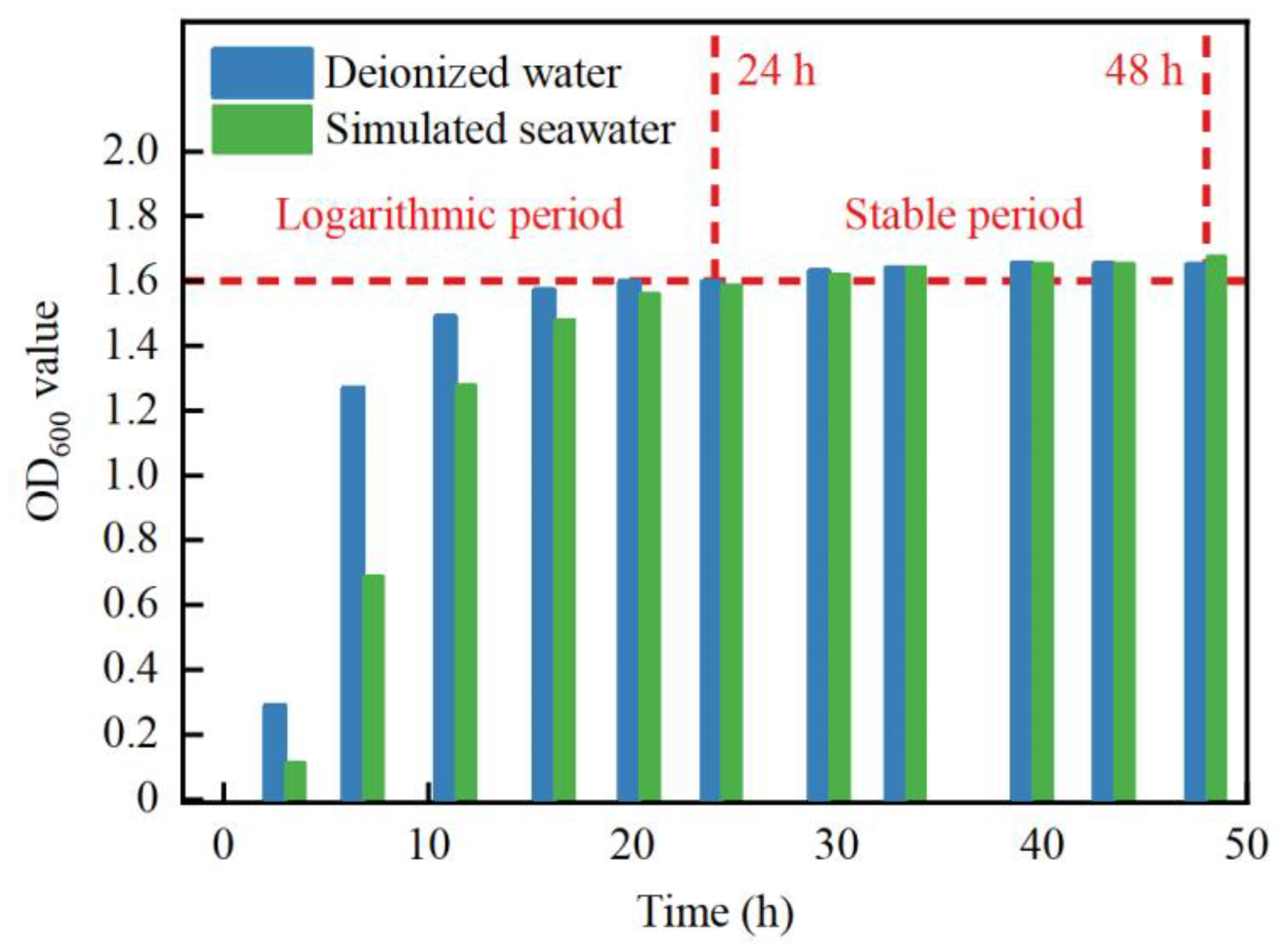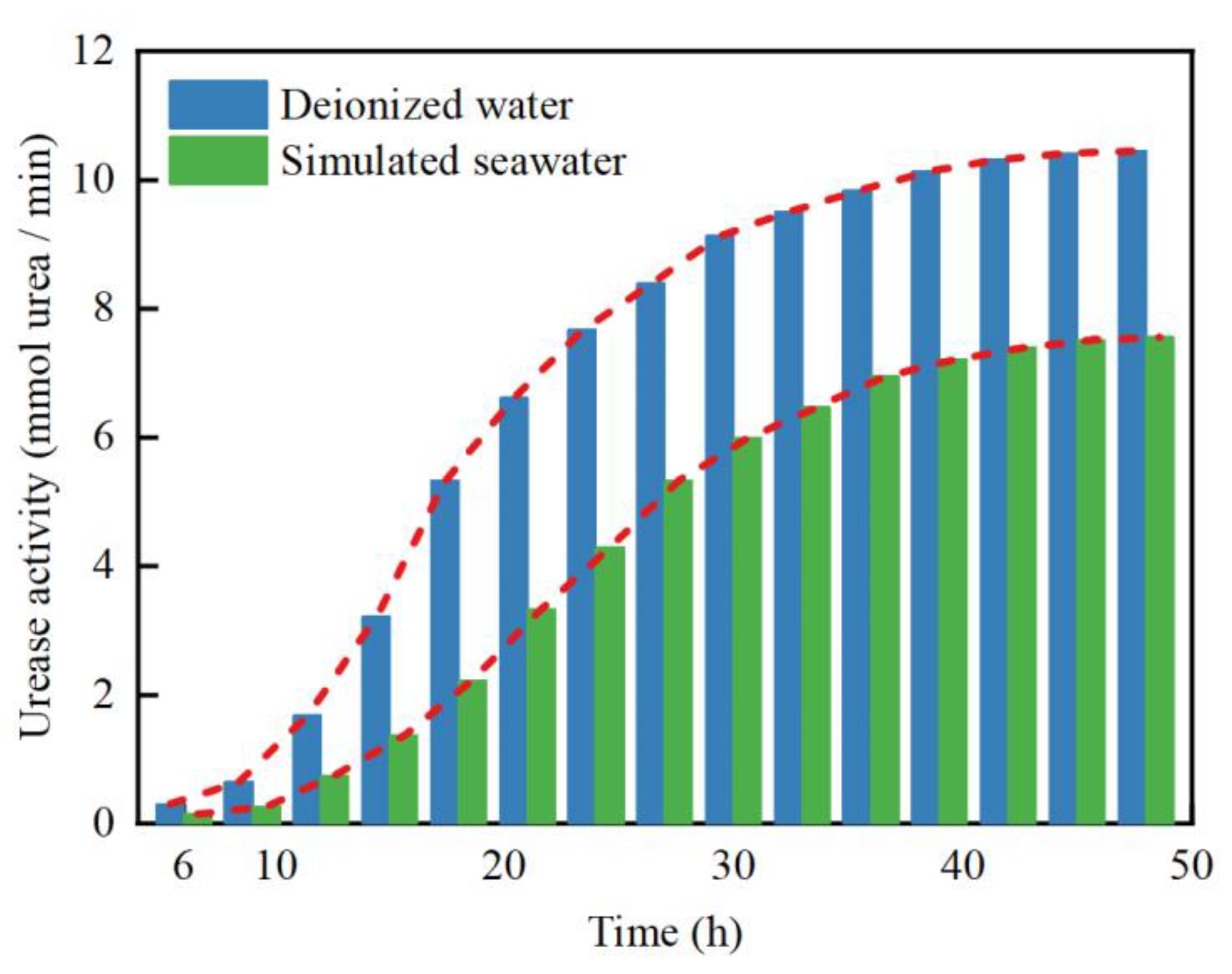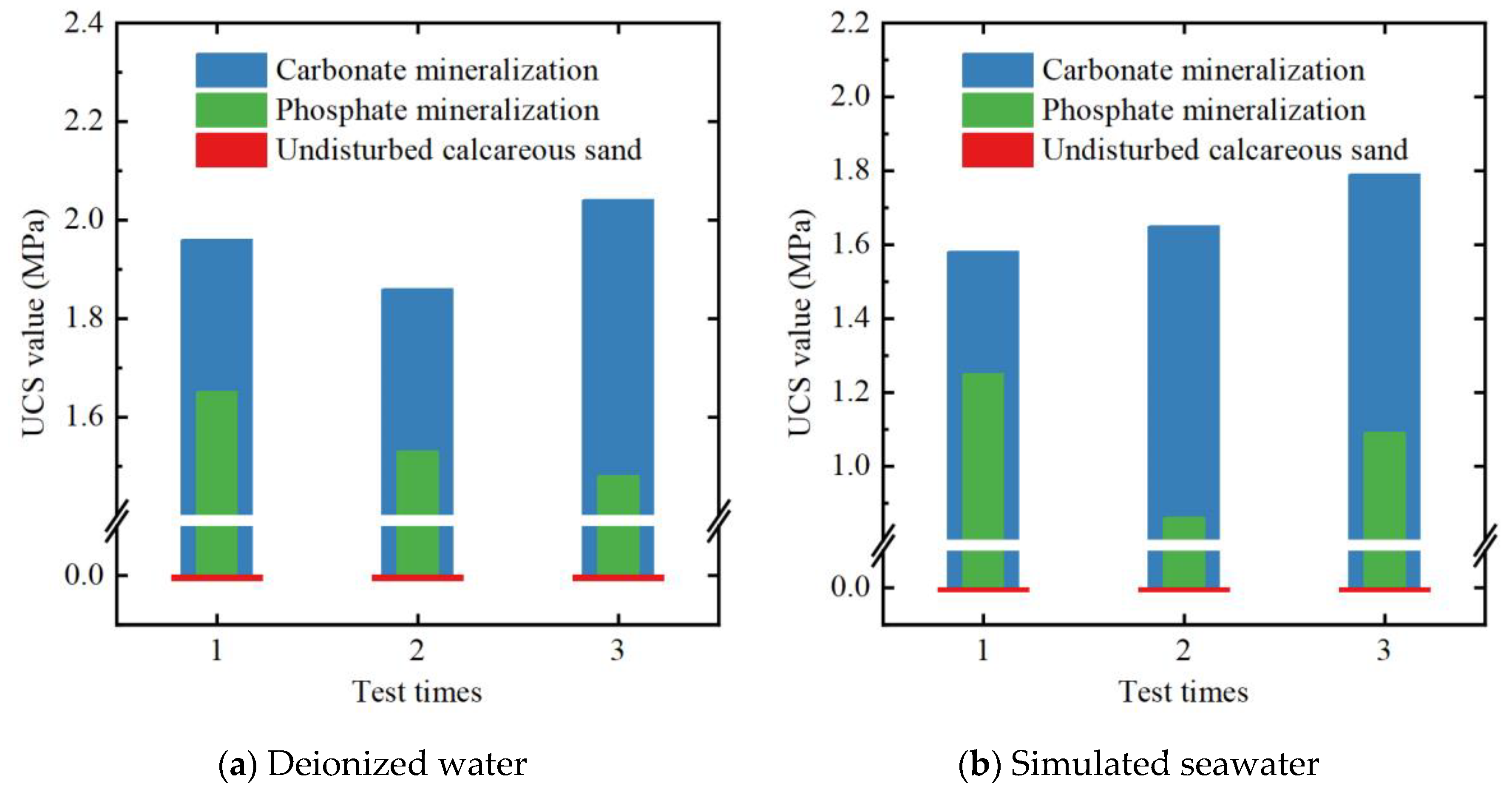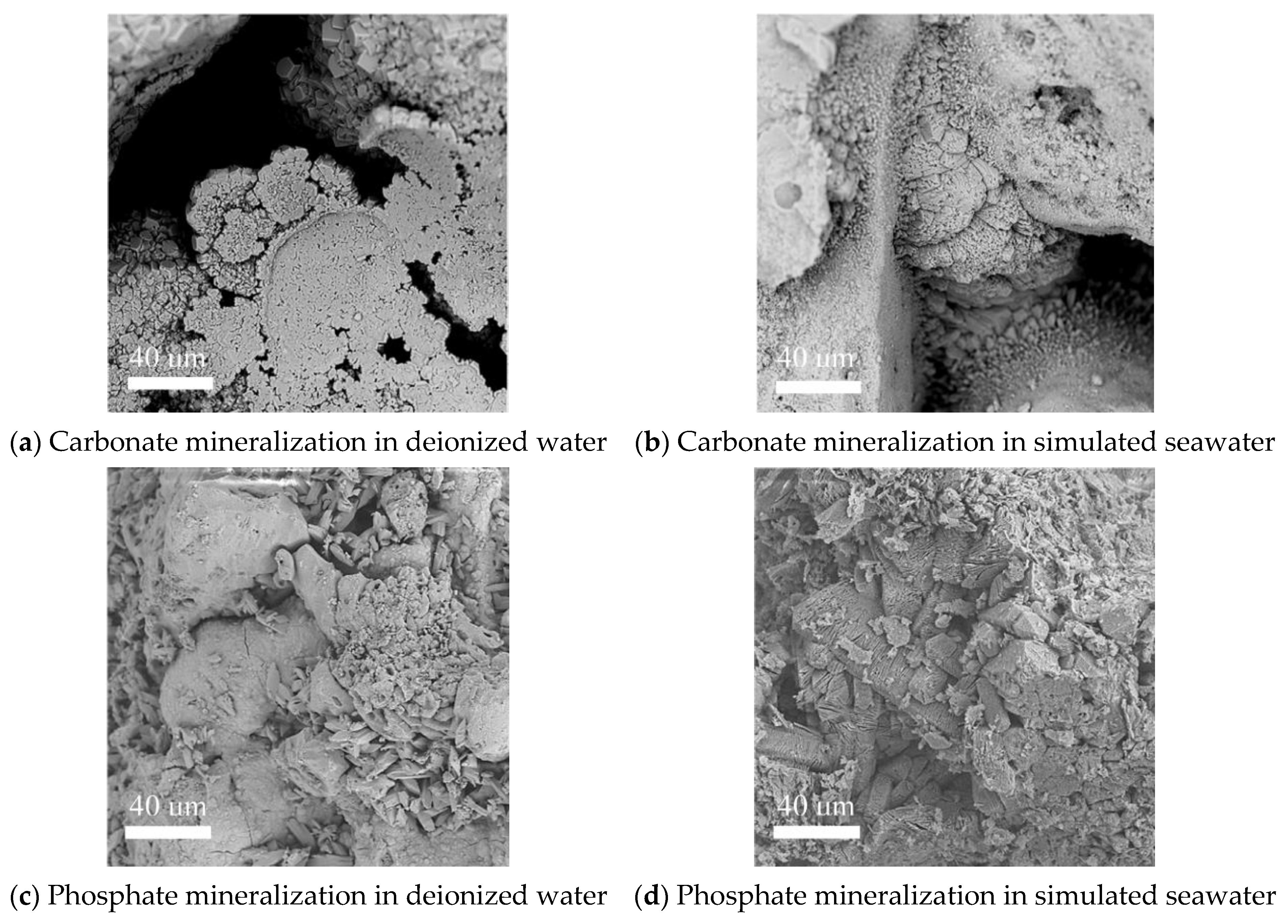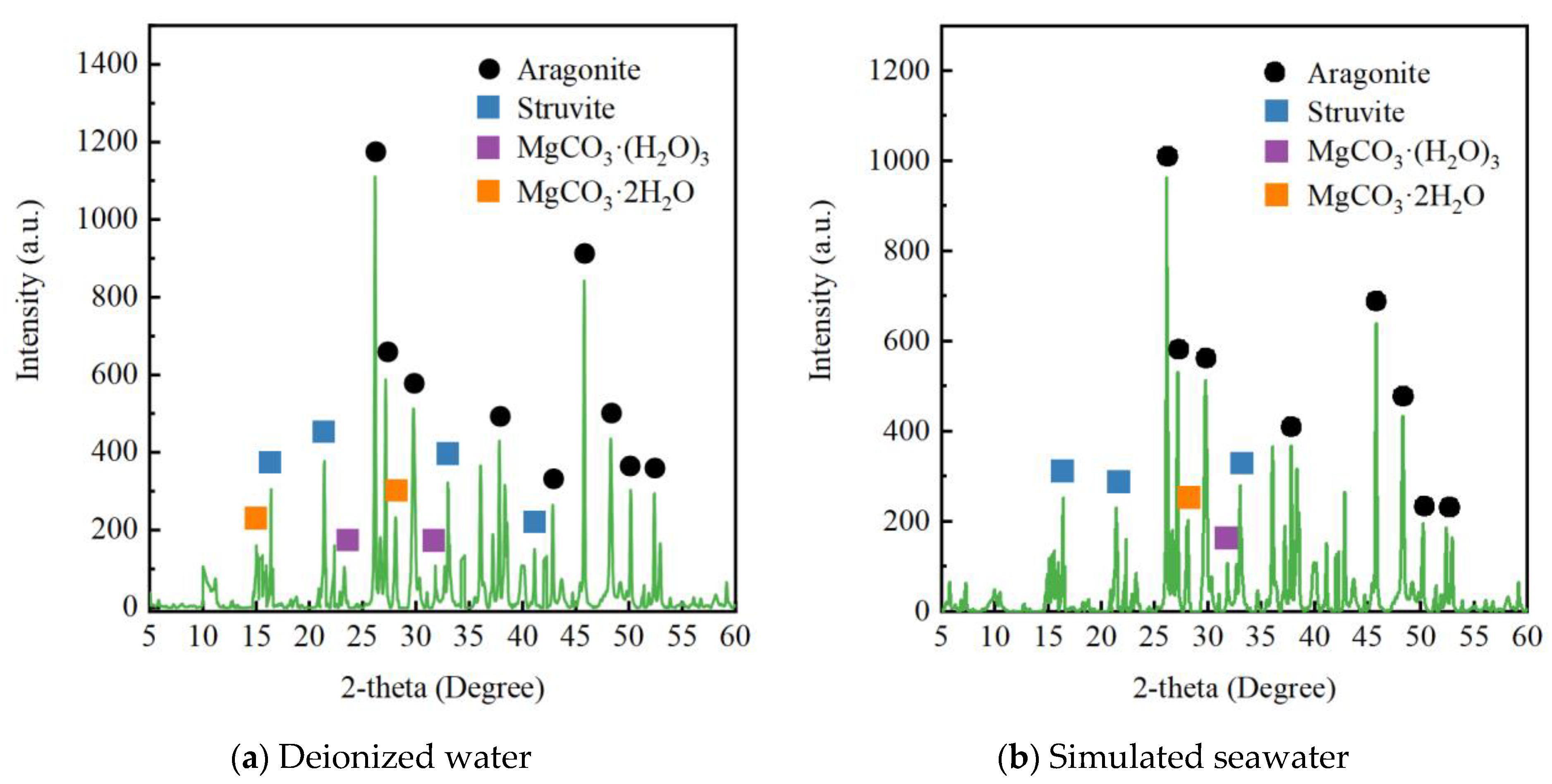1. Introduction
Soil improvement is one of the most important issues in geotechnical engineering. Cement-based materials are widely used in various soil improvement. However, nearly 5–7% of global carbon dioxide emissions come from the cement industry [
1], and the global carbon dioxide emissions rate is on the rise, causing serious harm to the environment. Microbial-induced biomineralization is a new sustainable soil improvement technology that can be a substitute for cement-based materials, especially for emerging economies with rapid infrastructure development [
2]. Use of agricultural urease to induce carbonate precipitation (referred to herein as EICP, or Enzyme Induced Carbonate Precipitation) can also be used for soil improvement [
3]. The very small size of the urease enzyme sub-unit (on the order of 12 nm) suggests that EICP can penetrate finer grained soils and may be less susceptible to bio-plugging than microbial-induced biomineralization. However, the disadvantage of EICP is that nucleation points for precipitation provided by the microbes in biomineralization are not present [
4].
Microbial-induced biomineralization mainly means that microorganisms change the surrounding environmental conditions through their own life activities, thereby controlling the formation and crystallization shape and size of minerals to achieve specific functions of mineralization. In nature, microorganisms are widely distributed and have the ability to induce the deposition of carbonate, phosphate, sulfate and other minerals [
5,
6,
7,
8]. In recent years, microbial mineralization has achieved good results in material improvement, concrete self-repair, ancient building protection and other fields [
9,
10,
11,
12]. The field of biomineralization includes a multidisciplinary research involving experts from various fields. However, several efforts need to be made to address key research and development questions necessary for commercial scale applications. Successful commercialization of the technique requires economical alternatives of the medium ingredients that cost as high as 60% of the total operating costs. Fortunately, use of inexpensive materials as corn steep liquor (CSL) or lactose mother liquor (LML) may help to lower the cost of treatment [
13,
14].
At present, the widely studied microbial mineralization process is mainly based on urea hydrolysis. Urease-producing microorganisms hydrolyze urea to produce carbonate ions and ammonium ions, maintain the alkaline environment needed for most microbial mineralization, and finally achieve biomineralization [
6]. Therefore, in the selection of microorganisms, it is necessary to select microorganisms rich in urease and decomposable urea and fully evaluate the effect of the application environment on the microbial growth and urease activity. The selection of the composition and concentration of a mineralization solution is directly related to the type and quantity of mineralization products, which need to ensure good mineralization effects and environmental friendliness. Currently, carbonate and phosphate mineralization products are the main types of available mineralization products.
There are many factors that affect microbial mineralization, in addition to the influence of microorganisms and mineralization solution, but these factors are also related to the properties of the treated materials. Due to the different physical and chemical properties, such as the inherent composition and particle size distribution of the materials, there may be many differences in the mineralization effect of different treatment materials during mineralization treatment. A series of experimental results that use carbonate precipitation as the product of microbial mineralization show that sand more easily realizes mineralization and can effectively improve its mechanical strength [
15], and the mineralization effect of clay is mainly reflected in the improvement in the water stability and strength after treatment [
16,
17]. The stability and strength of residual soil and shale soil in freeze-thaw areas are also enhanced after microbial mineralization treatment [
18]. For silty soil, the use of crude urease collected after microbial pyrolysis for mineralization treatment is better than the use of live bacteria [
19].
In addition to the study of carbonate microbial mineralization, the study of phosphate as a mineralization product has received increasing attention from scholars [
7,
20,
21]. Unlike carbonate mineralization, phosphate mineralization mainly uses ammonium ions produced by hydrolysis of urea. In alkaline environments, hydrogen phosphate ions and magnesium ions are introduced to react together to form magnesium ammonium phosphate and magnesium phosphate precipitates as mineralization products to improve the mechanical properties of the treated materials. Phosphate mineralization requires the participation of ammonium ions, which eliminates the potential environmental impact of ammonium ions to a certain extent, so it is more environmentally friendly.
Calcareous sand is a kind of engineering soil with calcium carbonate as the main composition, and it is widely distributed in many marine environments. It has poor mechanical properties, is easy to break and has high compressibility. Therefore, it is not suitable for direct use as a foundation, and it must be strengthened. For the mineralization treatment of the same material, the reinforcement effect, application conditions and environmental factors are considered, and it is very important to choose the appropriate microbial mineralization method, so it is necessary to compare the effects of different microbial mineralization treatments. In view of this, under the conditions of deionized water and simulated seawater, the effect of carbonate and phosphate precipitation mineralization induced by Sporosarcina pasteurii in strengthening calcareous sand is experimentally compared and evaluated.
3. Results and Discussion
3.1. Growth and Urease Activity of Microorganisms
3.1.1. Growth of Sporosarcina pasteurii
Figure 3 shows the growth curve of
Sporosarcina pasteurii under fresh water and simulated seawater conditions. The growth of
Sporosarcina pasteurii was inhibited to a certain extent in the saline environment with 0.6 mol/L sodium chloride, and the growth of bacteria appeared to be a small lag phase. In the logarithmic phase of approximately 24 h, the OD
600 value was smaller than that of culture without sodium chloride. After 24 h, the OD
600 values of bacteria in the two environments were similar, and the OD
600 values of bacteria in the stable period of 48 h showed almost no difference.
In the simulated seawater environment, due to the increase in osmotic pressure and ionic strength, the number of bacteria in the logarithmic phase was lower and there was a lag compared with normal growth, so simulated seawater had an adverse effect on Sporosarcina pasteurii. However, after 24 h, in the stable period of bacterial culture, the inhibition was basically lifted, especially in the harvest period of Pasteurella multocida in 48 h, and the OD600 value of Sporosarcina pasteurii cultured in simulated seawater was even slightly higher than that under normal conditions. This shows that Sporosarcina pasteurii can adapt to this kind of simulated seawater environment, can grow and reproduce normally, and can be used as a candidate bacteria for microbial mineralization under simulated seawater conditions.
3.1.2. Urease Activity of Sporosarcina pasteurii
Figure 4 shows the variation curve of urease activity of
Sporosarcina pasteurii with time under the fresh water and simulated seawater conditions. During the whole culture period, the urease activity of sodium chloride supplemented with 0.6 mol/L was always lower than that of
Sporosarcina pasteurii cultured in deionized water. At a harvest time of 48 h, the urease activity of the bacterial liquid in the two groups tended to be stable and reached the maximum value.
The salinity of seawater can inhibit the urease activity of
Sporosarcina pasteurii. Compared with the changes in its growth quantity, it can be found that although the salinity condition of seawater has little effect on the final number of
Sporosarcina pasteurii, it has a great influence on urease activity. Usually, because the cell membrane itself belongs to the osmotic membrane, when the concentration of sodium chloride is high, it will exhibit a concentration difference compared to the cytoplasm of microorganisms, thereby resulting in water extravasation within microorganisms, causing cell dehydration, and reducing the activity of intracellular enzymes [
21].
Generally, under simulated seawater conditions,
Sporosarcina pasteurii can grow, reproduce normally and retain most of the urease activity. There is evidence that
Sporosarcina pasteurii can grow at salinities equal to 100% sea water [
24], and
Sporosarcina pasteurii can effectively induce mineralization under the condition of simulated seawater and is suitable to be used as a dominant strain for the treatment of calcareous sand by microbial mineralization.
3.2. Permeability Test Results and Analysis
After different mineralization treatments, the permeability of the washed sand column was tested and compared with that of undisturbed calcareous sand. The results are shown in
Figure 5. The permeability coefficient of calcareous sand after carbonate mineralization and phosphate mineralization is significantly lower than that of undisturbed calcareous sand, which can be reduced by an order of magnitude. In comparison, regardless of the condition of deionized water or simulated seawater, the effect of carbonate mineralization on the permeability is more obvious, and the permeability coefficient of calcareous sand decreases more after treatment. For the two mineralization methods, after the addition of 0.6 mol/L of sodium chloride, the effect of mineralization treatment on the permeability of calcareous sand is weakened, but it is still much lower than that of the nontreatment condition, which fully shows that the two mineralization methods can obviously change the permeability of calcareous sand after treatment, and the effect of carbonate mineralization is more obvious.
There are many pores in the undisturbed calcareous sand, such as the inner pores of calcareous sand particles and the pores between particles. Therefore, before treatment, the permeability coefficient and permeability are higher than those after treatment. After mineralization, due to the formation, precipitation and accumulation of carbonate and phosphate mineralized products, the pores will be plugged, and the seepage channel will be blocked or partially closed, thereby resulting in a significant decrease in permeability. The comparison of the changes in permeability shows that carbonate biomineralization reduces the permeability of calcareous sand, thereby indicating that carbonate mineralization products fill more pores. This may be because the calcareous sand itself is mainly composed of calcium carbonate, which has better compatibility with the newly formed carbonate mineralization products, resulting in a more obvious decrease in its permeability. Salinity has an adverse effect on mineralization, and under this unfavorable condition, the permeability of calcareous sand treated by phosphate mineralization is more affected. This may be due to the existence of salinity; the stacking structure of phosphate mineralization products will change and then affect the pore filling efficiency, so the mineralization effect will experience a greater affect.
3.3. UCS Test Results and Analysis
The results of the UCS test are shown in
Figure 6. After mineralization treatment, the mechanical strength of calcareous sand is obviously improved, and the average UCS strength is higher than 1 MPa. In comparison, the strength of UCS after carbonate mineralization is higher, while that of UCS after phosphate mineralization is slightly lower, which corresponds to the change in permeability. As the carbonate mineralization products fill more pores, it is not easy for calcareous sand particles to move relatively to each other after experiencing stress. Especially after mineralization, the original loose sand cementation as a whole greatly improves the mechanical strength. The effect of salinity on the UCS strength is similar to its effect on permeability. After adding sodium chloride, the UCS strength of the calcareous sand column decreases to varying degrees, while the UCS strength of calcareous sand treated with phosphate mineralization decreases more. As the reaction in the process of phosphate mineralization is more complex and affected by a variety of regulatory factors, the mineralization effect may be more sensitive to the existence of adverse effects.
Generally, the effect of carbonate mineralization is better than that of phosphate mineralization, the permeability decreases more and the UCS strength is higher. As an unfavorable factor in mineralization treatment, simulated seawater has a substantial influence on phosphate mineralization. However, from the point of view of environmental protection, phosphate mineralization treatment obviously has more advantages because of the consumption of ammonium ions, and the permeability and UCS value of calcareous sand are significantly improved compared with those of undisturbed calcareous sand, which can meet the needs of general engineering.
3.4. SEM Test Results
The results of the SEM test are shown in
Figure 7.
Figure 7a,b show that after carbonate mineralization, the surface of calcareous sand mineralized under the condition of deionized water is covered with a layer of dense carbonate products, which should be calcium carbonate according to the test conditions. Calcium carbonate wraps the calcareous sand particles, fills the intergranular pores and causes the sand particles to be cemented together, which finally reduces the permeability of calcareous sand and improves its mechanical strength. Although the calcareous sand mineralized under the condition of simulated seawater also produces calcium carbonate between grains, due to the adverse effect of salinity, the amount of calcium carbonate is low, so its mineralization effect is weakened to a certain extent.
Figure 7c,d shows that after phosphate mineralization, under the condition of deionized water, the main phosphate mineralization product is an obliquely long column, which is speculated to be magnesium ammonium phosphate, and there are some irregular cluster-like substances, which may be byproducts. The phosphate mineralization products accumulate in the pores between particles and are cemented to the surface of calcareous sand particles; under the condition of simulated seawater, the morphology of long columnar magnesium ammonium phosphate changes obviously, and the oblique column of magnesium ammonium phosphate is mainly formed by lamellar crystal stacking. There are obvious pores between flake crystals, and there are a large number of irregular mineralization products in the figure. In recent studies, it has been found that salinity has an effect on the stacking structure of magnesium ammonium phosphate; this causes the crystal shape to change from a long column to a flake [
21], which is consistent with the results of this experiment. The lamellar accumulation retains some pores, and the seepage channel is retained, so it easily moves and compresses under stress and the mineralization effect is lower than that under deionized water.
In comparison, the mineral crystal packing density and size of carbonate are better than those of phosphate mineralization, so the mineralization effect is better, the permeability decreases more and the UCS strength is higher.
3.5. XRD Test Results
After washing and drying, the samples were fully ground, and the composition of the XRD test was analyzed.
Figure 8a,b shows the XRD test results of the samples after carbonate mineralization, and
Figure 9a,b gives the XRD test results of the samples after phosphate mineralization.
For the calcareous sand after carbonate mineralization, the XRD results show that the newly formed carbonate mineralization product is calcium carbonate and that the crystal form is calcite, which is different from the inherent crystal type of calcium carbonate (aragonite). Calcite is the most stable crystal form of calcium carbonate in a natural state, and its mechanical properties are good, so calcite improves the mechanical strength of calcareous sand [
25]. For calcareous sand after phosphate mineralization, the main mineralized product is magnesium ammonium phosphate hexahydrate, but due to the occurrence of side reactions, there are small amounts of magnesium carbonate dihydrate and trihydrate, which are amorphous minerals in the SEM diagram.
4. Conclusions
In this paper, the effects of mineralization treatment of calcareous sand with different mineralization products were compared. The main conclusions are as follows: (1) Sporosarcina pasteurii can induce mineralization under simulated seawater conditions. After microbial mineralization of calcareous sand with carbonate mineralization products and phosphate mineralization products, the permeability of calcareous sand decreases significantly, and the UCS strength increases obviously. Among them, the effect of carbonate mineralization is better than that of phosphate mineralization. (2) The main product of carbonate mineralization is calcium carbonate, and the crystal form is calcite; the main component of the phosphate mineralization product is magnesium ammonium phosphate hexahydrate, and the dihydrate and trihydrate of magnesium carbonate are also formed in the process of mineralization. (3) Although the effect of phosphate mineralization is slightly weaker than that of carbonate mineralization, the method itself is more environmentally friendly, and the mineralization effect can meet the needs of general engineering, so it has great application potential.


